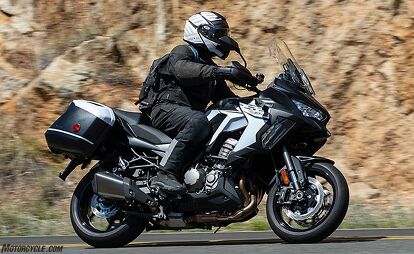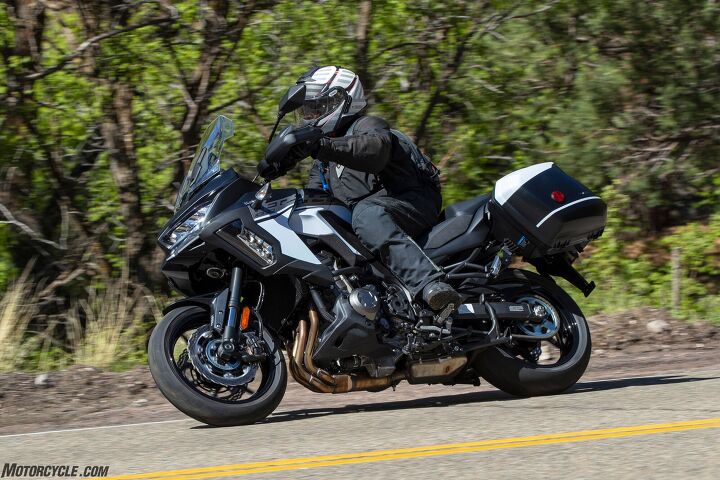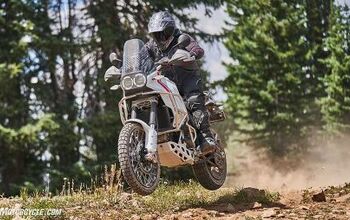2019 Kawasaki Versys 1000 SE LT+ Review First Ride
Kawasaki launches the big Versys into the 21st century
What’s not to like, really? Kawasaki’s “versatile system” Versys sisters – X 300, 650 and 1000 – are all just that, versatile bikes for all seasons. But now that there’s a lot more competition in the adventurish sporty roadbike segment than there used to be, the Versys 1000 felt like it needed to keep up with the Joneses.
2019 Kawasaki Versys 1000 SE LT+
| Engine | 17.0/20 |
| Suspension/Handling | 14.0/15 |
| Transmission/Clutch | 8.5/10 |
| Brakes | 9.0/10 |
| Instruments/Controls | 4.5/5 |
| Ergonomics/Comfort | 9.0/10 |
| Appearance/Quality | 9.5/10 |
| Desirability | 8.5/10 |
| Value | 9.5/10 |
| Overall Score | 89.5/100 |
To that end, Kawasaki threw the works at it for 2019. Now we’ve got electronic suspension, a full ride-by-wire engine with ride modes and cruise control, a 6-axis Bosch IMU communicating with new rider aids, all-new bodywork and windscreen, a new color-TFT display dash, the ability to Bluetooth up to your phone and use Kawasaki’s own proprietary Rideology app, quickshifter, LED lighting and cornering lights, yada yada yada…
It’s like this Versys really wants to be a hi-tech Euro-bike. The experts keep telling us that’s where all the money is in the current market. It feels like Kawi added everything they could to this one to launch it into the “premium” motorcycle segment, and as long as somebody else is expectorating the $17,999, we’re down with that.
Has the seat always been this high? Apparently yes: According to our last comparo including the Versys, 33.1 inches is same as before. That’s really about as high as my 30-inch legs like to go for an everyday motorcycle, big toes just able to reach the ground on either side at once. The new dash with TFT display really has taken things decidedly upscale, along with all the new switchgear buttons necessary to operate all the new stuff.
Once rolling, our new electronic suspension (KECS) is pretty swell: a 43mm inverted Showa cartridge fork in front and Showa BFRC lite rear shock, each with 5.9 inches of travel. If you’re good at electronics, you can go in there and punch in your damping settings, compression and rebound, front and rear. And you can specify rear preload also: Rider, Rider with Luggage, Rider with Passenger and Luggage… As for me, I set my preload to R with L and left it alone. From there, it’s super-easy to just choose one of three modes with the left thumb switches on the fly: Rain (soft power and damping), Road (full power and medium damping) or Sport (full power and stiffer damping). The last mode, Rider, lets you customize and store your own settings. (You’ll need to dig the 5mm hex key out of the toolkit to adjust front preload, at the bottom of the left fork leg.)
Kawi says: The forks and shock have built-in stroke sensors that provide real-time stroke speed and compression information. The sensor coils provide input to the KECS ECU every millisecond. This is complemented by information provided by the IMU (acceleration/deceleration) every 10 milliseconds, and the FI ECU (vehicle speed) every 10 milliseconds. The KECS ECU then directs current to the solenoids to adjust damping as required by the situation. This results in quick reaction time to road conditions and maintains a natural feeling that is crucial to the ride feeling at one with the motorcycle.
Indubitably. It just feels like really dialled suspension to me, and Road was fine for all the riding we did; every time we’d come to a nice set of twisties with itchy throttle fingers, we’d get stuck behind a minivan or dump truck and/or have to stop to shoot more photos. It would’ve been good, though, to put ’er in Sport and give the Versys the whip. The new IMU also helps coordinate your KCMF (Kawasaki Cornering Management Function), which is your KIBS (Integrated Braking System) and KTRC (Traction Control), meaning that it’s almost impossible to fall off and hurt yourself theoretically:
The latest Bosch compact IMU is new for the Versys 1000 SE LT+ in 2019, and weighs in at only 40 grams. The IMU allows an additional layer of precision to be added to the already high-level components. The system uses minimal hardware but complex Kawasaki proprietary software. IMU enables inertia along six DOF (degrees of freedom) to be monitored. Acceleration along longitudinal, transverse and vertical axes, plus roll rate and pitch rate are measured. The sixth axis, yaw rate, is calculated by the ECU using Kawasaki original proprietary software developed through World Superbike racing experience. The motorcycle’s ECU gains an even clearer real-time picture of chassis orientation, and its software is uniquely predictive as it combines chassis orientation information with real time monitoring of the rider’s intentions to enable the control systems to maximize forward acceleration.
The 1043 cc inline Four is still the torque-rich smoothie it’s always been, and fuelling via the new ride-by-wire system is impeccable. I thought it felt like the engine had maybe lost a step, but the dyno doesn’t back me up on that. What it could be is the 31 pounds the new bike has gained over the 565-lb. 2015 model. Oh dear. I wonder if we left the saddlebags off when we weighed the old bike? They’re still not 31 lbs…
Anyway, it’s not exactly a lightweight, which goes a long way toward explaining why Kawasaki, wisely, doesn’t try to make the Versys into a real “ADV bike.” This one more falls into that gray area also occupied by the Honda VFR1200X – motorcycles made for pavement but with the ability to also take on graded dirt roads.
The new quickshifter is kind of a mixed bag; instant upshifts are excellent at bigger throttle openings when you’re riding aggressively, but more hit-and-miss when you’re just bumbling down the road at low rpm, often needing more than one jab of the shifter. You sort of just revert to the clutch, which isn’t a big deal at all. Downshifts are nearly always right on the money, and it’s fun to rush up to corners on the brakes and bang out a couple of quick ones, even down to first gear in tight corners, whilst letting the slip/assist clutch do its thing.
The bigger problem for me is that the footpegs are rubber-mounted to squelch vibration, which introduces a kind of imprecise rubbery feel to every shift I don’t remember our previous big Versys having. A couple of times at stops I actually checked to see if anything was about to fall off? Nothing was. Other riders I asked said that rubbery feel didn’t really bother them. Could be just one of those things you adjust to.
Speaking of which, for me this is one of the smoothest-running big four-cylinders I’ve ridden, thanks to the front engine mounts being rubberized, along with the aforementioned footpegs and the tapered steel handlebar… and yet, that didn’t stop one guy on the ride from complaining the handlebar buzz was putting his hands to sleep. It just goes to show you, ah, something. Motorcycles can be really subjective. I think 98% of riders would agree the thing is really smooth.
While we’re on top of this pile of mattresses, I might as well say the thick, broad seat was slightly firm for my taste, the handlebar a smidge too far forward for 5’8” me. But I think if you’re taller or larger, you’ll love the way this one fits: Its payload is 485 pounds.
When it was time to get back to LA from Flagstaff, Kawasaki let me take the Versys instead of the Airbus. It was 39 degrees up there at 7700 feet on I-40 at 8 am, but actually not bad inside my Aerostich with the heated grips on high, behind the handguards; the new windscreen and fairing provide more wind protection for torso, head and legs than the sleek looks would lead you to believe. I switched into Rain mode and enjoyed the plush ride; the 75% power the engine delivers in Rain is still plenty for high-speed freeway cruising. Sadly, cruise control won’t let you cruise faster than 85 mph, which is not quite as high-speed as it could be on some stretches of that wide-open desert highway. It’s for your own good. Kawasaki loves you most.
Running along mostly between 85 and quite a bit more with the windscreen all the way up, the bike returned about 36 mpg, which should give you almost 200 miles from the 5.5-gallon tank. Makes you wonder how BMW gets 50 mpg from its new 1250 boxer? Our 2015 Versys got 40 mpg in mixed use.
And don’t forget the self-healing paint Kawasaki applied to the bike’s most vulnerable dorsal surfaces. Park it in the sun for a while, and many light scratches from zippers and things are supposed to magically disappear. Go ahead and slap on that magnetic tank bag. I can’t quite bring myself to scratch the bike on purpose, but I may have to for the sake of Science.
For now, your only color option is this Metallic Flat Spark Black/Pearl Flat Stardust White, which is almost but not quite matt, sort of a really cool gun-metal gray with a hint of metal flake. Really quite nice. In fact, so is the whole dang bike. Which is as it should be for $18,000. At that point, you’re on the threshold of things like the BMW S1000 XR or a Ducati Multistrada. Traditional Kawasaki buyers want nothing to do with either of those Euro-bikes, which will far exceed $18k by the time you add on all the stuff the Kawasaki comes with. But Kawi only wants $1,001 more for its own supercharged H2 SX, which comes standard with cruise control but not saddlebags.
Decisions, decisions. I fear the H2 would be a ticket magnet. Atop the black-and-white Versys, though, you almost look like an authority figure. Depends on whether you do more sport-touring or more sport-touring I suppose. By the time I got home from Arizona after those 480 miles and seven hours, my butt was a bit winded from the firm seat, but the rest of me was great. This is a super-nice motorcycle, and beats commercial aviation by a long shot. Welcome to the 21st century, Versys 1000.
2019 Kawasaki Versys 1000 SE LT+
+ Highs
- Super-comfy mile-eater sporty tourer, esp. if you’re large
- All the latest electronics keep you upright and cruising
- Smooth-running, perfect-fueling, torque gravy boat
– Sighs
- Rubbery shifter is kind of annoying
- The electronics interface isn’t easy, but you’ll figure it out
- 36 mpg isn’t great for a 107-hp bike
In Gear

Helmet: Shoei Neotec 2 $799
- Suit: Aerostich Roadcrafter 3 $1,237
- Gloves: Reax Superfly Mesh $69
Boots: Alpinestars Campeche Drystar $250
2019 Kawasaki Versys 1000 SE LT+ Specifications | |
|---|---|
| MSRP | $17,999 |
| Engine | 4-stroke, 4-cylinder, DOHC, 16-valve, liquid-cooled |
| Displacement | 1043cc |
| Bore x Stroke | 77.0 x 56.0mm |
| Compression Ratio | 10.3:1 |
| Fuel System | DFI with 38mm Keihin ETV throttle bodies (4) |
| Ignition | TCBI with digital advance |
| Transmission | 6-speed, return shift, Kawasaki Quick Shifter (KQS) |
| Final Drive | Sealed chain |
| Electronic Rider Aids | Kawasaki Electronic Control Suspension (KECS), Kawasaki Cornering Management Function (KCMF), Kawasaki Traction Control (KTRC), Kawasaki Intelligent anti-lock Brake System (KIBS), Kawasaki Quick Shifter (KQS) (dual direction), Electronic Cruise Control, LED Cornering Lights |
| Frame Type | Twin-spar aluminum |
| Front Suspension / Wheel Travel | 43mm inverted fork with KECS-controlled rebound and compression damping, manual spring preload adjustability and top-out springs; 5.9 inches of travel |
| Rear Suspension / Wheel Travel | Horizontal back-link New Uni-Trak, BFRC gas charged shock with piggyback reservoir, KECS-controlled compression and rebound damping electronically-adjustable spring preload; 5.9 inches of travel |
| Front Tire | 120/70 ZR-17 |
| Rear Tire | 180/55 ZR17 |
| Front Brakes | Dual 310mm petal-style discs with four-piston calipers, ABS |
| Rear Brakes | Single 250mm petal disc with single-piston caliper, ABS |
| Rake/Trail | 27.0°/4.0 inches |
| Overall Length | 89.4 inches |
| Overall Width | 37.4 inches |
| Overall Height | 58.7 inches/60.2 inches (windshield down/up) |
| Ground Clearance | 5.9 inches |
| Seat Height | 33.1 inches |
| Wet Weight | 596 lb (MO scales, including saddlebags) |
| Fuel Capacity | 5.5 gallons |
| Fuel Economy | 36 mpg (observed) |
| Wheelbase | 59.8 inches |
| Special Features | Rideology the App Smartphone Connectivity, TFT Instrumentation, Highly Durable Paint, LED Headlight, LED Cornering Lights, LED Taillight |
| Color Choices | Metallic Flat Spark Black/Pearl Flat Stardust White |
| Warranty | 24 Month Limited Warranty |
| Kawasaki Protection Plus (optional) | 12, 24, 36 or 48 months |
We are committed to finding, researching, and recommending the best products. We earn commissions from purchases you make using the retail links in our product reviews. Learn more about how this works.
More by John Burns






































































Comments
Join the conversation
Never liked the looks of the big Versys, but for some reason the 650 looks just fine to me. No way I'd pay $18K for one of these. A supercharged Versys 650 with this kind of power and these features, yes, if they keep it under 500lbs.
I looked at a Versys 650 & thought it would be the perfect bike if it was just bigger, heavier & more expensive.